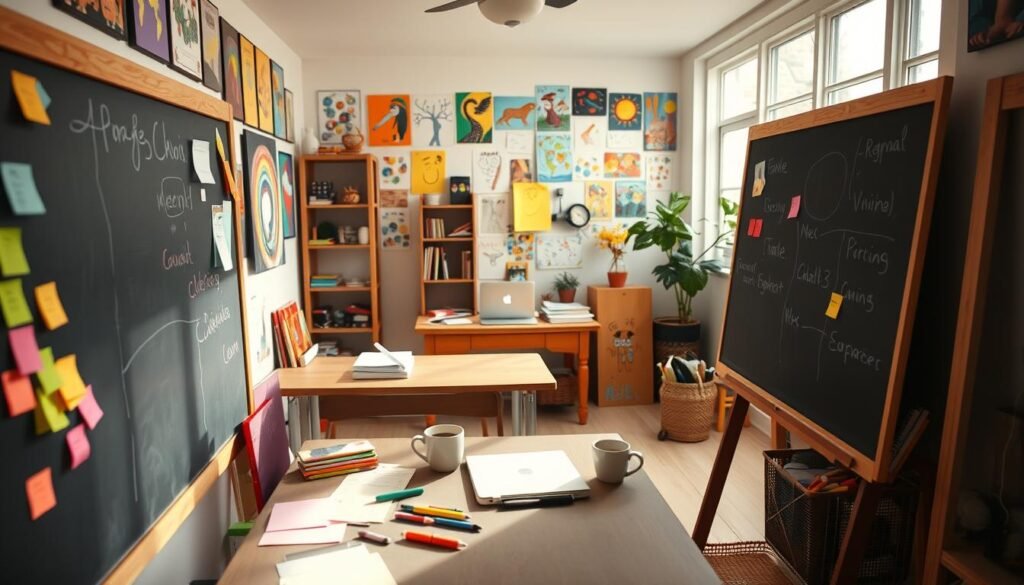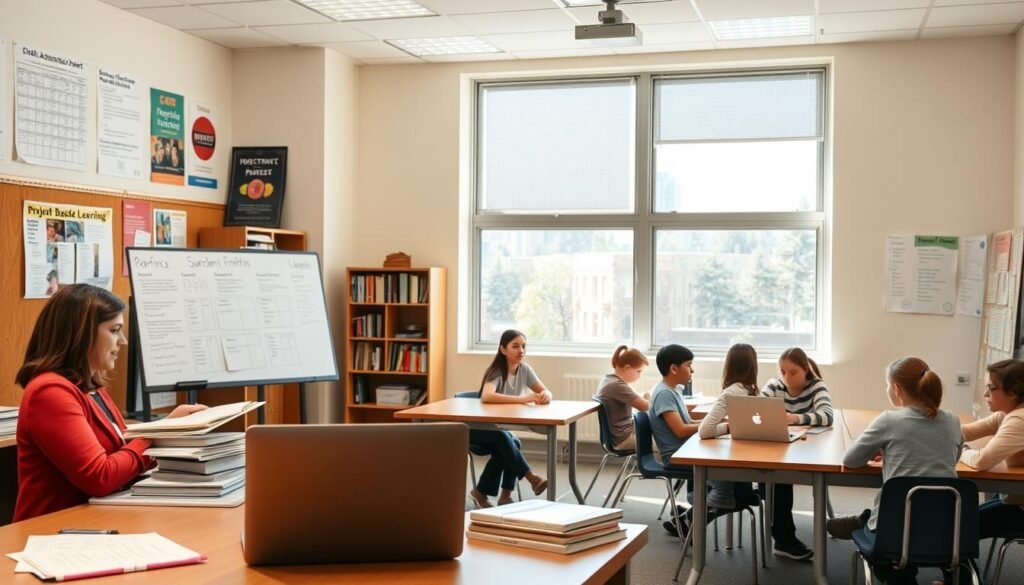
Changing your homeschooling to a project-based learning (PBL) schedule can change your child’s learning experience. This new approach opens up new ways of learning that go beyond old teaching methods.
Project-based learning lets students take charge of their learning. It’s different from old teaching ways. PBL helps students think critically, be creative, and solve real-world problems. This prepares them for the future.
Your PBL homeschool schedule is a great way to make learning fun and hands-on. Students get to explore subjects deeply. They see how what they learn applies to real life, making learning exciting and meaningful.
Table of Contents
Understanding Project-Based Learning in a PBL Homeschool Schedule
A PBL homeschool schedule transforms homeschooling by making learning fun and interactive. It replaces traditional education with a lively, engaging approach. With 85% of teachers reporting that project-based learning (PBL) enhances critical thinking, it’s an excellent way to boost your child’s education.
Core Components of an Effective PBL Homeschool Schedule
A PBL homeschool schedule places students at the center of their learning experience. It ensures learning is meaningful by focusing on:
- Real-world scenario exploration
- Professional task simulation
- Inquiry-based learning strategies
- Collaborative project development
- Cross-curricular integration
Benefits of a Student-Centered PBL Homeschool Schedule
Studies show that implementing a PBL homeschool schedule brings significant benefits. In fact, 70% of students feel more motivated with PBL. Key advantages include:
- 30% higher student engagement
- 20% better information retention
- 25% better collaboration skills
- More creativity and innovation
Real-World Application in a PBL Homeschool Schedule
A PBL homeschool schedule connects education with real-life experiences, allowing students to learn by doing rather than memorizing. Statistics show that 80% of projects integrate technology, helping students develop practical skills for the future.
PBL turns education into an active journey of discovery. It lets students take charge of their learning.
Creating Your PBL Homeschool Schedule
Creating a flexible schedule for project-based learning (PBL) makes your homeschool unique. It uses personalized education strategies. Your schedule should be adaptable but still have clear learning goals.
Understanding your student’s learning style is key to PBL scheduling. Flexible scheduling lets students explore projects deeply. This approach fosters real learning experiences.
“Learning is not about time spent, but knowledge gained.” – Progressive Education Advocate
Think about a dynamic schedule that mixes core subjects with project time:
- Set aside time for project research
- Make room for working together
- Include time for reflection
- Let students choose their projects
Make sure your schedule has realistic project timelines. Some projects might take weeks or months. This depends on how complex they are and how much students are involved.
Important scheduling tips include:
- Start the day with basic skills
- Use the afternoon for project work
- Check in weekly on progress
- Give students time to finish projects
The aim is to create a place where curiosity grows. It should encourage students to think for themselves through smart, flexible scheduling.
Integrating Technology into Your PBL Homeschool Schedule
Technology has changed project-based learning, making it more exciting for homeschool students. It lets them dive into learning in new ways. With digital tools, you can turn learning into fun, interactive projects that make them think and explore.
Today’s project-based learning uses technology to its fullest. It gives students great ways to learn, create, and share. Your homeschool can be a leader in learning by using digital tools for hands-on activities and learning from different subjects.
Digital Tools for PBL Homeschool Project Management
Good project management is key in project-based learning. Here are some digital tools to help with your homeschool:
- Trello for visual project tracking
- Google Workspace for collaborative documents
- Padlet for interactive brainstorming
- Notion for comprehensive project planning
Online Resources and Platforms for a PBL Homeschool Schedule
Many online platforms can make your project-based learning better. Sites like Khan Academy, Coursera, and EdX have free courses. They help add to your curriculum and give extra learning chances.
Virtual Collaboration in a PBL Homeschool Schedule
Technology lets homeschool students work with others all over the world. Virtual exchange programs, online forums, and project platforms help them learn from different cultures.
By using technology wisely, you can make learning fun and engaging. It prepares students for today’s digital world while keeping the heart of project-based learning.
Designing Cross-Curricular Projects in a PBL Homeschool Schedule

Creating a dynamic homeschooling curriculum means breaking down old subject barriers. Project-based learning is a great way to link different subjects. It helps students understand complex topics better.
Your cross-curricular projects can make learning fun by mixing subjects. By designing projects that combine science, history, literature, and math, you help your kids see how different subjects are connected.
- Identify project themes that span multiple subjects
- Create interconnected learning experiences
- Develop comprehensive understanding through integrated learning
For example, a historical research project could include:
| Subject | Learning Objectives |
|---|---|
| History | Research historical events and context |
| Mathematics | Calculate population statistics or economic data |
| Writing | Create narrative or analytical reports |
| Geography | Map historical locations and migrations |
The FutureFit Projects show the strength of cross-curricular learning. These projects add to regular lessons by mixing five inquiry-based milestones. They blend academic concepts with skills like critical thinking and collaboration.
By using an interdisciplinary approach to project-based learning, you make planning easier. You also create engaging educational experiences. These prepare your children for the challenges of the real world.
Implementing a Flexible PBL Homeschool Learning Environment
Creating a dynamic homeschool environment is more than just teaching. It’s about making your home a personalized education center. This center adapts to your child’s unique learning needs.
Designing an effective learning space needs creativity and planning. Your homeschool environment should support hands-on activities. It should also be flexible to explore different learning styles.
Adapting Your PBL Homeschool Schedule to Student Needs
Every child learns in their own way. Personalized education means tailoring your approach to fit your student’s strengths and interests. Here are some strategies:
- Observe your child’s learning preferences
- Create multiple learning zones in your home
- Use loop scheduling to prevent burnout
- Rotate activities to maintain engagement
Time Management in a PBL Homeschool Schedule
Effective time management is key in a flexible homeschool setting. A well-structured approach helps balance educational goals with your child’s learning pace.
- Plan weekly schedules in six-week chunks
- Allow spontaneous learning opportunities
- Incorporate breaks and downtime
- Use academic blocks between 9 AM and 12 PM
Creating Effective Learning Spaces for a PBL Homeschool
Your learning environment should inspire curiosity and support diverse educational activities. Design spaces that are:
- Comfortable and well-lit
- Organized with accessible learning materials
- Flexible enough to accommodate different projects
- Equipped with technology and hands-on learning tools
“The best learning environments are those that adapt and grow with the student’s evolving needs.” – Homeschool Education Expert
Assessment Methods in a PBL Homeschool Schedule

Tracking progress in a PBL homeschool schedule needs new ways to measure success. It’s not just about grades. It’s about seeing how your child grows in their learning journey.
Student-centered learning uses many ways to check how well your child is doing. Here are some key methods to assess PBL projects:
- Create detailed project rubrics that outline clear expectations
- Implement self-assessment tools to encourage student reflection
- Develop digital portfolios showcasing project progression
- Use narrative feedback instead of traditional letter grades
The TruSpark motivations assessment is a special way to see how engaged your child is. It’s a 15-minute test that finds out what motivates your child the most. This helps make learning more personal.
The success of a project is largely measured by the learning process, not just the final outcome.
Your PBL homeschool schedule can use many ways to check progress. It’s not just about grades. It’s about seeing how your child grows in many areas. Consider tracking:
- Critical thinking development
- Problem-solving skills
- Collaborative abilities
- Creative approach to challenges
By using these flexible ways to assess, you’ll make learning more meaningful. It will show how your child’s educational journey is unfolding.
Building Student Independence in a PBL Homeschool Schedule
Project-based learning lets students take charge of their learning. Homeschoolers can gain skills that go beyond school. This approach makes students active in their education.
For PBL to work, we need to teach students to be independent. Studies show PBL students can retain information 20% better than others.
Self-Directed Learning Strategies for a PBL Homeschool Schedule
To start, give students the right tools and strategies:
- Create flexible project selection frameworks
- Encourage student-led research methodologies
- Implement weekly reflection journals
- Provide resources for independent exploration
Goal Setting & Progress Tracking in a PBL Homeschool Schedule
“The secret of getting ahead is getting started.” – Mark Twain
Setting goals makes learning active. Students can use digital tools like:
- Digital task planners
- Progress tracking spreadsheets
- Weekly check-in templates
- Visual goal-mapping applications
Portfolio Development for a PBL Homeschool Schedule
A project portfolio shows student growth and skills. It proves what students have learned. Students can collect digital and physical items that show their learning journey.
By using these strategies, homeschoolers make project-based learning a powerful tool. It helps students develop skills for a lifetime and think independently.
Conclusion: Embracing the Power of PBL in Homeschooling
Your homeschooling journey can change with a project-based learning (PBL) approach. This method makes learning exciting and real. Students learn by doing, which sparks their curiosity and critical thinking.
Project-based learning makes education personal. Studies show 75% of homeschooled students love learning more when they do projects. This way, they learn better and develop skills like problem-solving and creativity.
By choosing project-based learning, you’re preparing your kids for the future. They learn to adapt and think creatively. 85% of parents see better critical thinking skills in their kids. This shows how powerful PBL is for growing students.
Make education your own. Homeschooling is about more than grades. It’s about raising curious, motivated kids who can change the world. Join families who are changing education with project-based learning.
